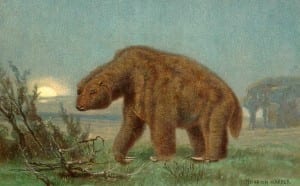When the age of the dinosaurs ended around 65 million years ago, mammals stepped in to fill the gap, and the age of the placentals began. However, whether early placental mammals were already present on Earth before the demise of the dinosaurs has been the subject of a long standing debate. Recent research in GEE used genomic data, in combination with fossil evidence, to show that the earliest placental mammals were indeed scurrying between the feet of dinosaurs.
 The huge diversity of placental mammals on Earth today first appeared shortly after the mass extinction event that killed the dinosaurs. It is thought that the loss of the dinosaurs, along with much of life on Earth, freed up niches which placental mammals to evolved to fill. But were early placental mammals present, waiting in the wings, during the age of the dinosaurs, or did they appear rapidly after their demise? One recent study suggested that, based on fossil evidence, the placental mammals must have appeared after the cretaceous-tertiary boundary (KT) when dinosaurs and most life on Earth was wiped out. However, a recent paper by GEE’s Mario dos Reis and Ziheng Yang, in collaboration with Philip Donoghue from the University of Bristol, highlights flaws in the methods used in this study, and utilitsed a more thorough approach to show that early placental mammals likely predated the KT boundary.
The huge diversity of placental mammals on Earth today first appeared shortly after the mass extinction event that killed the dinosaurs. It is thought that the loss of the dinosaurs, along with much of life on Earth, freed up niches which placental mammals to evolved to fill. But were early placental mammals present, waiting in the wings, during the age of the dinosaurs, or did they appear rapidly after their demise? One recent study suggested that, based on fossil evidence, the placental mammals must have appeared after the cretaceous-tertiary boundary (KT) when dinosaurs and most life on Earth was wiped out. However, a recent paper by GEE’s Mario dos Reis and Ziheng Yang, in collaboration with Philip Donoghue from the University of Bristol, highlights flaws in the methods used in this study, and utilitsed a more thorough approach to show that early placental mammals likely predated the KT boundary.
Using genetic sequence data from over 14,000 genes, combined with fossil evidence, GEE researchers applied 3 alternative statistical methods to estimate the age of the earliest placental mammal; ancestor to all modern placental mammals. Although different statistical methods yielded slightly different estimates, and differed in their accuracy, they all agreed that placental mammals must have already been around before the dinosaurs went extinct. The adaptive radiation of mammals that occurred after the extinction of the dinosaurs was dramatic, but it was initiated by a few shrew-like species which had already evolved. This study highlights the importance of using statistical methods to estimate the true age of ancestral species; the age of the oldest fossils is not the same as the age of the ancestral species that gave rise to them, and statistical techniques must be employed to estimate this. Using both molecular and fossil evidence to inform estimates also provides more robust evidence for the true age of the first placental mammals, and the theory that the earliest ancestors of placentals predated the disappearance of the dinosaurs.
Original Article:

This research was made possible by funding from the Biotechnology and Biological Sciences Research Council (BBSRC).
 Sloths might be notorious for their leisurely pace of life, but research published last year shows they are no slow coaches when it comes to evolution.
Sloths might be notorious for their leisurely pace of life, but research published last year shows they are no slow coaches when it comes to evolution. Close
Close


 The huge diversity of placental mammals on Earth today first appeared shortly after the mass extinction event that killed the dinosaurs. It is thought that the loss of the dinosaurs, along with much of life on Earth, freed up niches which placental mammals to evolved to fill. But were early placental mammals present, waiting in the wings, during the age of the dinosaurs, or did they appear rapidly after their demise? One recent study suggested that, based on fossil evidence, the placental mammals must have appeared after the cretaceous-tertiary boundary (KT) when dinosaurs and most life on Earth was wiped out. However, a recent paper by GEE’s Mario dos Reis and Ziheng Yang, in collaboration with Philip Donoghue from the University of Bristol, highlights flaws in the methods used in this study, and utilitsed a more thorough approach to show that early placental mammals likely predated the KT boundary.
The huge diversity of placental mammals on Earth today first appeared shortly after the mass extinction event that killed the dinosaurs. It is thought that the loss of the dinosaurs, along with much of life on Earth, freed up niches which placental mammals to evolved to fill. But were early placental mammals present, waiting in the wings, during the age of the dinosaurs, or did they appear rapidly after their demise? One recent study suggested that, based on fossil evidence, the placental mammals must have appeared after the cretaceous-tertiary boundary (KT) when dinosaurs and most life on Earth was wiped out. However, a recent paper by GEE’s Mario dos Reis and Ziheng Yang, in collaboration with Philip Donoghue from the University of Bristol, highlights flaws in the methods used in this study, and utilitsed a more thorough approach to show that early placental mammals likely predated the KT boundary.